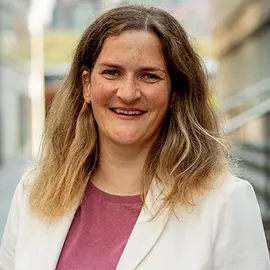Definition and validation of use cases for the application of the MyoSuit
Description
This project aimed to further develop and implement in the market a wearable robot, the Myosuit from MyoSwiss AG, to support people with mobility impairments. We worked together with key stakeholders involved in the care of people with mobility impairments to better understand their needs and expectations to implement such technology as part of their daily lives.We first started with expert interviews with secondary and tertiary stakeholders representing nursing care, organisations for older adults, physiotherapy, rehabilitation, health prevention, interaction design and bioethics resulted in the following main themes:
- Myosuit as an assistive or training de-vice for use in clinics or at home,
- usability of the hardware (specifically independent donning and doffing to allow for home use), and
- financing and access to the technology.
We developed several cases based on these results and which covered the possible user groups of older adults, athletes during rehabilitation, and adults with neurological conditions.From our interviews, we prioritized the use case of the Myosuit as an assistive device for older adults. This represents a very novel and not yet established area of use. The prioritized use cases were validated in focus groups with physiotherapists and interviews with older adults who had tested the technology. Physiotherapists considered the Myosuit as highly interesting especially for users that require assistance at home. Focus group discussions revealed that adaptions regarding aspects of practicability of the hardware and user interface, and overall simplicity for older adults are necessary from the physiotherapists’ perspectives; these learnings are projected to be implemented in a future version of the Myosuit for home use. To further understand this specific group, six older adults were recruited from outpatient clinics to test the Myosuit at the clinic, or if they were interested, at home. The interviews following the introduction to the Myosuit showed that older adults are generally interested in the technology and consider using it as assistive device for walking and daily life activities. Different barriers and facilitators were identified and informed an overview of possible changes that can improve usability and adoption from a primary user perspective. The main priorities were the simplification of the donning and doffing processes, simplification of the interface used to control the Myosuit, and improvements of the supporting material/information to improve the introduction to the technology.We used the feedback from the interviews and the use cases described above to create a plan for short-term and long-term implementation of possible changes. The short-term changes have been implemented on the product - for example, the user interface has been simplified to improve usa-bility - and supporting services to simplify the usage by healthcare professionals. The long-term changes are now part of Myoswiss’ continuous development of the product and will be implement-ed in the future.One important outcome of the project was the clarification of needs and requirements for future versions of the Myosuit. We are now planning to use the current version of the product and branch it into two, more specialized, versions: one targeting clinical use and one targeting home use. These versions will allow us to better meet the needs raised by stakeholders in this project. For example, lightweight older adults highlighted the importance of having a lighter version of the Myosuit which would make it easier for them to use it for longer periods of time. On the other hands, healthcare professionals need a system that optimizes donning for implementation in their daily work.Based on a survey and interviews with physiotherapists who had experience with using the Myosuit, key factors to address for implementation in the outpatient setting were determined. These interviews revealed the need for more detailed information and training material for specific aspects of the Myosuit (e.g., donning/doffing). Also, the need for a peer group to initiate regular exchange between therapists using the Myosuit was identified. Based on these results, an expert in strategic communication evaluated the current onboarding material and recommended streamlining the web-site and optimizing the use of channels for the specific target group.Despite major improvements in wearable robots over the past years, this technology is at an early stage regarding market adoption. The outcomes of this project have improved the Myosuit and will continue to inform the development of future versions of the Myosuit as we continue to bring such technology to the masses. This will continue to be an iterative process as more people use the technology and more insights are gained about their usage in daily life.
Key data
Co-Projectlead
Dr. Jaime Duarte, Prof. Dr. Eveline Graf
Project team
Prof. Dr. Karmen Franinovic, Leah Reicherzer, Dr. Mandy Scheermesser, Dr. Colette Schneider Stingelin, Christa Wachter Oberli
Project partners
MyoSwiss AG; Zürcher Hochschule der Künste ZHdK / Fachrichtung Interaction Design
Project status
completed, 06/2020 - 12/2022
Institute/Centre
Institute of Physiotherapy (IPT); Institute of Multilingual Communication (IMK)
Funding partner
Innovationsprojekt / Projekt Nr. 41253.1 IP-SBM
Publications
-
Barriers and facilitators to the use of wearable robots as assistive devices : qualitative study with older adults and physiotherapists
2024 Reicherzer, Leah; Scheermesser, Mandy; Kläy, Adrian; Duarte, Jaime; Graf, Eveline
-
Barriers and facilitators to the use of wearable robots as assistive devices : views and experiences of older adults and physiotherapists
2023 Reicherzer, Leah; Scheermesser, Mandy; Kläy, Adrian; Duarte, Jaime E.; Graf, Eveline
